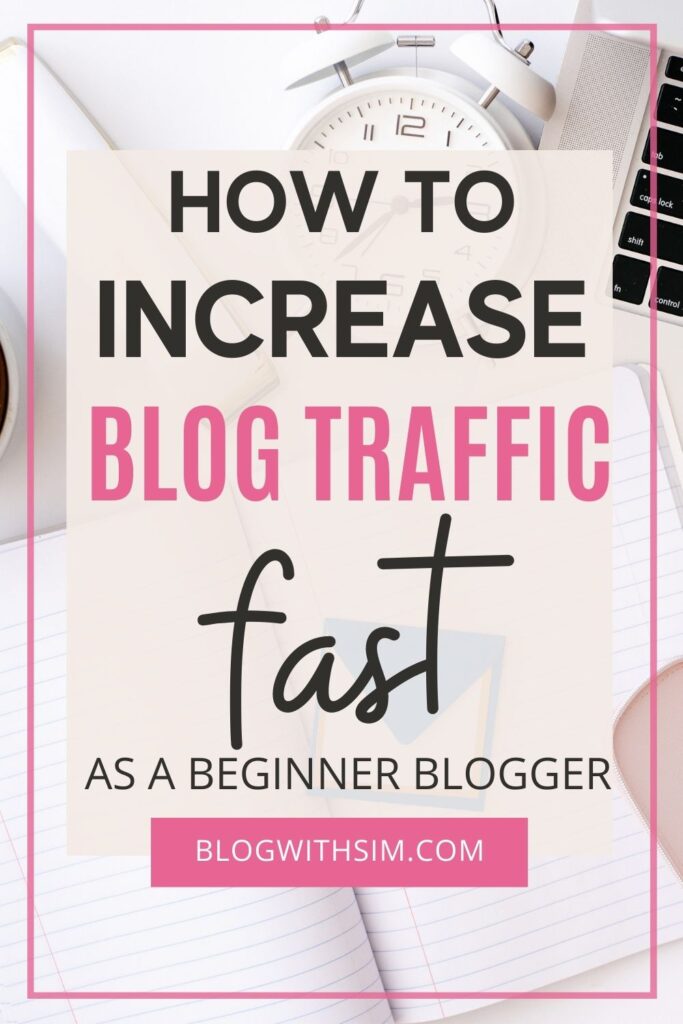Blog traffic is a must for any blog’s success. Though you don’t need tons of traffic to make money from a blog, it is the most important component of a successful blog. If you have started a blog and wondering how to increase blog traffic fast, read this and apply the strategies listed here to your blog.

How to increase blog traffic fast to wordpress site
As a beginner, there are many ways to get traffic. I am not saying to become a total SEO nerd( it is difficult in the beginning). Even after a few years, if you will not learn SEO, you will not be able to.
Posts you need to write on your blog
The very first thing to do is to write 4-5 Pillar posts to start with. And then, from there, you can start building your blog. Your pillar post should be 2000 to 5000 words long.
As a beginner, it is difficult to write, but aim for this and write around 500 words in one sitting. I am sure you would be able to do it.
Block your time for a particular time and start writing.
When you have finished writing for that time, you will be amazed at your own capability. During that time, you have to remove all the distractions and focus on the task in hand. When you have finished writing those 500 words, you would be better positioned to write more.
The work did give us the motivation to do more. Also, write the evergreen content. Evergreen content is not time-based or relevant to a specific time. It is always consistent, and if you later find that you need to update the content, you can still do that. Long-form content does well on google.
You may not be able to rank on google for now, but writing long-form content will give Google better signals about your blog. Long-form content should be easily readable. And it should be optimized for search engines too.
You don’t need to be an SEO expert while starting out, though you will learn a lot along the way. But paying attention to the on-page SEO will definitely help ou a to.
How to get traffic to your blog
There are many ways to get traffic to a new blog. Google will take tme to rank your website. In the meantime you can use other tactics to drive traffic to your blog. Social media is a great place to drive traffic .
Social media for traffic
Not all social media platforms are great for driving traffic to your blog. As of now, Pinterest gives you the best ROI for driving traffic.
To drive traffic from Pinterest, you should create an account and have an optimized profile on Pinterest.
You can read more how to start an account on Pinterest
There are a few tips you should always remember while writing down your posts.
1. Know your audience
You should know for whom you are writing. Creating a persona for your audience will help you with whom you want to write. Know the problems your audience face and then start writing for them.
There are a few things you have to know about your audience:
- Challenges they face
- Demographics
- Interests of your audience
- Solutions they search for on the web
2. Headings: Break your post into lines, starting with H2 entries and then writing the H3 headings points. There should be the metadata for your job, which will display in SERPS. Use keywords in Title and headings. This will give Google a signal about your blog.
2. Use smaller paragraphs of 2 to 3 sentences.
Though we have to write long-form content for Google, it is said that readers only skim the content. So your content should be easily skimmable. There should be enough white space for the readers to feel comfortable. These are a few things, when done right, can help you build your blog the right way. Or you can say you will remove the after headaches. I have a blog that I don’t even want to edit or update because of the hotchpotch I have done there. The next part is Pinterest. Pinterest is the gold mine for readers and bloggers. Business owners and bloggers can get a lot of traffic from Pinterest. Instead of wasting time on too many channels, it would be great to grow your account on any two platforms.
3. Write 4-5 Pillar posts
Pillar posts are the pillars for your blog to bear the blog weight.
Pillar posts answer the questions about the topic and you can use those pillar posts to build backlinking which is a necessity for SEO purposes. Often your pillar posts will start ranking on Google. Because of the links generated, Google will get signals that these posts are written to find answers for the queries of readers.
A pillar post is a Topic in a nutshell and it should answer most of the questions surrounding that particular seed keyword. All other posts should be that branches coming out of this main keyword.
All those posts should be interlinked to get the SEO juices flowing. These posts are written in long-form because they answer many questions related to that keyword.
4. Create evergreen long-form content
Evergreen content, as the name suggests, is forever. This type of content is not dependent on any specific time or event. It will always be relevant.
For example, How do you stay productive while working from home? Will always be relevant for the readers working from home.
But how to decorate your house during holidays”will only be relevant during the holiday season. You don’t have to upgrade the evergreen content often.
Google loves evergreen and long-form content. There are mixed views on how long the content should be.
Google loves long-form content, and people love to just skim through the content. It is up to you to find a sweet spot in between. Most of the successful bloggers advise writing between 1500-2000 words.
Also, try to write a few long-form pillar posts. These types of posts will answer most of the questions. Long-form content also helps you get backlinks. Use on-page SEO to optimize the blog posts
4. Use Keywords in the post and headings
As you know, your keyword, it is important to know where you have to use all the keywords. The very first thing to do is to include your main keyword in the blog post title.
Create at least two subheadings with the keyword in it. Also, sprinkle keywords in your blog post naturally. If you use the Yoast SEO plugin, you will get suggestions based on your blog post’s keyword usage.
5.Make your content easy to read
As we all know, we live in a very fast time. Nobody has time to sit and read long articles without any white space in between.
We have to write long-form content for Google and make it readable for readers. To make it easy to read for the readers, divide the content into headings and subheadings. This will help the readers to read what they want in the blog post.
Nobody wants to read long texts without white space. Write shorter paragraphs with two or three sentences.
6. Pinterest to get traffic
As a beginner, it is difficult to get traffic from Google. But Pinterest can do all the magic for you.
Pinterest is the goldmine for traffic for new bloggers. You can start getting traffic even in the initial months of your blogging journey. Though Pinterest is becoming smarter day by day, you can still get traffic from Pinterest with the correct strategies.
How to get traffic using Pinterest strategies
7. Promote on Social Media
This one is a really important thing to do. Don’t get overwhelmed by joining every social media platform but you can start with one or two.
Start with one and master that one before moving to the next.
I suggest you start with Pinterest because it is not just a social media platform; it is also a visual search engine. The results you will get for spending time on this platform are great.
You can try with Mix.com also. I have just started with this one but have heard that you can get some traffic from Mix.
Quora is another great place to get noticed. Answer the questions that people ask and link back to your blog post.
8. Facebook Groups
Facebook groups can help you get some traction initially. So get into a few of the Facebook groups.
Some of these groups do daily traffic threads which can help you to get some initial momentum.
9. Interlink your articles
Interlinking is the technique of adding links to your own relevant articles in the blog post. It is an important aspect of on-page SEO.
Internal linking your relevant articles strategically helps Google understand the relationship between different posts on your blog. This helps Google in showing the most relevant answer for the particular search.
A few of the benefits of interlinking are,
- Helps in pageviews,
- Increase the SEO value of your site,
- decrease bounce rate,
- Google loves interlining
10. A clean website design
Ask yourself a question, do you love to read a clean website or the one with lots of adds and other stuff?
Of course, we all love clean, clutter-free designs. So keep your website design clutter-free, which is possible if you use a minimalistic theme.
I use the Genesis theme on my website, and they are known for their speed and minimalistic design. If you want to start a website on a clean design theme, check here for genesis themes.
11. Create user-generated content
User generated content is developed through the questions and answers asked by users.
When you know what your users need, it will be easy for you to get traffic as your audience is looking for answers for those topics. Moreover, user-generated content helps you decrease the bounce rate as the readers will stay longer on your website.
12. Optimize website speed
Website speed is required both for user experience as well as for Google. This is the time of instant gratification, where we cannot wait for even a few seconds.
It is advised to optimize your website for speed and keeping it under 3 seconds. Even a change in milliseconds can impact the performance of your website.
13. Participate in question and answer websites
Answering the questions on this type of website can help your content stay ranking. Don’t just go there to link to your website; go there and genuinely answer to help the readers.
You can get backlinks if people like your answer and come back to your website to get a detailed explanation.
14. Make social sharing easy
Install a social sharing plugin so that the readers could share the blog post easily when they land on your page.
A study has found that having social buttons make it 7 times more sharable. In other words, with social sharing buttons, your content gets shared more. Use any plugin that helps in social sharing.
15. Start an Email list from start
Google can change, social media can change but the email list you own. Start building your email list from day one.

